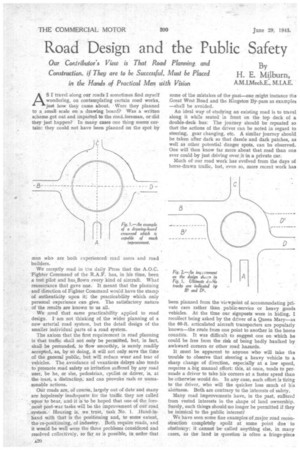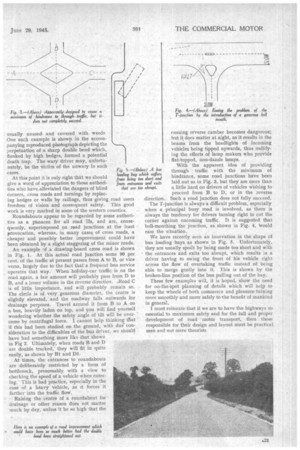Road Design and the Public Safety
Page 22

Page 23

If you've noticed an error in this article please click here to report it so we can fix it.
As r travel along our roads I sometimes find myself wondering, on contemplating certain road works, just how they came about. • Were they planned to a small scale on a drawing board? Was a written scheme got out and imparted to the road foreman, or did they just happen? In many cases one thing: seems certain: they could not have been. planned on the' spot by
men who are both experienced road users and road builders.
We recently read in tee. daily Press that the A.O.C. Fighter Command of the R.A.F, has, in his time, been a test pilot and has_flown every kind of aircraft. What reassurance that gave one. It meant that the planning and direction. of Fighter Command would have the stamp of authenticity upon it; the practicability which only personal experience can give. The satisfactory nature of the results are known to us all.
We need that same practicability applied to road design. I am not thinking of the wider planning of a new arterial road system, but the detail design of the smaller individual parts of a road system.
The axiom that the first requirement in road planning is that traffic shall not only be permitted, but, in fact, shall be persuaded, to flow smoothly, is surely readily accepted, as, by so doing, it will not only save the time of the general public, but will reduce wear and tear of vehicles. The avoidance of vexatious delays also tends to promote road safety as irritation suffered by any road user, be he, or she, pedestrian, cyclist or driver, is, at the least, a distraction, and can provoke rash or unreasonable actions.
Our roads are, of course, largely out of date and niany are hopelessly inadequate for the traffic they are called upon to bear, and it is to be hoped that one of the foremost post-war tasks will be the improvement of our road system. Housing is, we trust, task No. 1. Hand-inhand with that is the positioning and, to some extent, the re-positioning, of industry. Both require roads, and it would be well were the three problems considered and resolved collectively, so far as is possible, in order. that A20 some of the mistakes of the past—one might instance the Great West Road and the Kingston By-pass as examples —shall be avoided.
An ideal way of studying an existing road is to travel along it while seated in front on the top deck of a. double-deck bus: The journey should be repeated so that the actions of the driver can be noted in regard to steering, gear changing, etc. A similar journey should be taken after dark so that dazzle and dark patches, as well as other potential danger spots, can be observed. One will then know far more about that road than one ever could by just driving over it in a private car.
Much of our road work has evolved from the days of horse-drawn traffic, but, even so, more recent work has been planned from the viewpoint of accommodating private cars rather than public-service or heavy goods vehicles. At the time our signposts were in hiding, I recollect being asked by the driver of a Queen Mary—as the 60-ft. articulated aircraft transporters are popularly known—the route from one point to another in the home counties. It was difficult to suggest one on which he could be free from the risk of being badly baulked by awkward corners or other road hazards.
It must be apparent to anyone who will take the trouble to observe that steering a heavy vehicle to a sharp change of direction, especially at a low speed, requires a big manual effort: this, at once, tends to persuade a driver to take his corners at a faster speed than he otherwise would do. In any case, such effort is tiring to the driver, who will the quicker lose much of his alertness. Both are contrary to the interests of safety.
Many road improvements have, in the past, suffered from vested interests in the shape of land ownership. Surely, such things should no longer be permitted if they be inimical to the public interest?
We have seen some fine examples of major road reconstruction completely spoilt at some point due to obstinacy: it cannot be called anything else, in many cases, as the land in question is often a fringe-piece
usually unused and covered with weeds One such example is shown in the accompanying reproduced photograph depicting the perpetuation of a sharp double bend which, flanked by high hedges, formed a potential 'death trap. The wary driver may, unfortunately, be the victim of the unwary in such cases.
At this point it is only right that we should give a word of appreciation to those authorities who have alleviated the dangers of blind corners, cross roads and turnings by replacing hedges or walls by railings, thus giving_ road users freedom of vision and consequent safety. This good work is very marked in some of the western counties.
Roundabouts appear to be regarded by some authorities as a panacea for all road ills, and are, consequently, superimposed on read junctions at the least provocation, whereas, in many cases of cross roads, a cheaper and possibly better improvement could have been obtained by a slight staggering of the minor roads.
An example -A a drawing-board cross road is shown in Fig, 1. At this actual road junction some 90 per cent, of the traffic at present passes from A to B, or vice versa, largely due to the fact that a frequent bus service operates that way. When holiday-car traffic is on the road again, a fair amount will probably pass from D to B, and a lesser volume in the reverse direction. .Road C is of little importance, and will probably remain so. The circle is of very generous diameter, the centre is slightly elevated, and the roadway falls outwards for drainage purposes. Travel around it from B to A on a bus, heavily laden on top, and you will find yourself wondering whether the safety angle of tilt will be overcome by centrifugal force. I cannot help thinking that if this had been studied on the ground, with due consideration to the difficulties of the bus driver, we should have had something more like that shown in Fig 2. Ultimately, when roads B and D are double tracked, they will fit in quite easily, as shown by B1 and Dl.
At times, the entrances to roundabouts are deliberately restricted by a form of bottleneck, presumably with a Yiew to checking the speed of a vehicle when entering. • This is bad practice, especially in the case of a heavy vehicle, as it forces it farther into the traffic flow.
Raising the centre of a roundabout for drainage or other reason does not matter much by day, unless it be so high that the ensuing reverse camber becomes dangerous; but it does matter at night, as it results in the beams from the headlights of incoming vehicles being tipped upwards, thus nullifying the efforts of lamp makers who provide flat-topped, non-dazzle lamps.
With the apparent idea of providing through traffic with the minimum of hindrance, some road junctions have been laid out as in Fig. 3, but they are more than a little hard on drivers of vehicles wishing to proceed from B to D, or in the reverse direction. Such a road junction does not fully succeed.
The T-junction is always a difficult problem, especially when a principal busy road is involved, as there is always the tendency for drivers turning right to cut the corner against oncoming traffic. It is suggested that bell-mouthing the junction, as shown in Fig. 4, Would ease the situation.
We have recently seen an innovation in the shape of bus loading-bays as shown in Fig. 5. • Unfortunately, they are usually spoilt by being made too short and with the entrances and exits too abrupt, which results in a driver having to swing the front of his vehicle right across the flow of overtaking traffic instead of being able to merge gently into it. This is shown by the broken-line position of the bus pulling out of the bay.
These few examples will, it is hoped, show the need for on-the-spot planning of details which will help to keep the wheels of both commerce and pleasure turning more smoothly and more safely to the benefit of mankind in general •
I must reiterate that if we are to have the highways so essential to maximum safety and for the full and proper development of road 'motor transport, then those responsible for their design and layout must be practical men and not mere theorists




















































